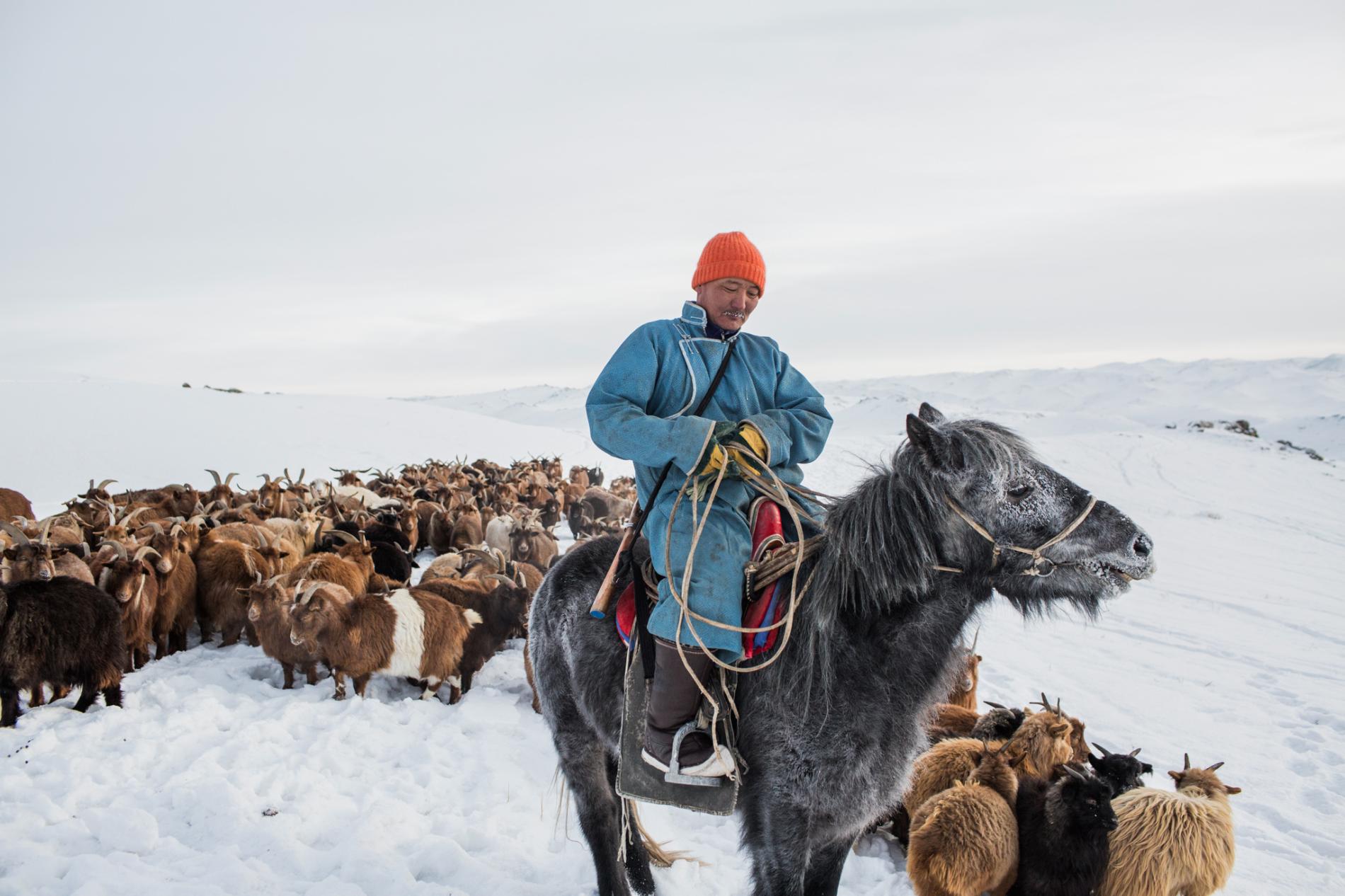Widely distributed throughout the country are several outstanding local breeds of sheep. They are fat-tailed carpet wool breeds and admirably adapted to cold environments. These different breeds of sheep undoubtedly constitute a valuable, although little-known, component of the animal genetic resources of the world. The estimated total number of sheep at the end of 1987 was 13.6 million, made up of many indigenous breeds, 15 of which are described in this post.
These breeds are located in different climatic belts and at varying altitudes in the mountains, hills, plains and sandy deserts of the country.
Sheep in Mongolia may be grouped into five types. The common native sheep are multipurpose and low in productivity. The other four are used more specifically for their meat (mutton), carpet wool, milk and good-quality lambskins. Grazing is on year-round pastures with no supplementary feeding, even under severe winter and spring conditions. The sheep are well adapted to the unfavourable ecological conditions of steep mountains and poor vegetation.
One distinctive feature of the native coarse wool fat-tailed sheep is noticeable when new grass grows on the pasture: at this time they grow rapidly, are easy to fatten and have a remarkable ability to store 4 to 6 kg of fat around the kidneys, mesentery and the tail bone. This fat is drawn on in winter and spring.
Sheep are reared according to the natural and economic conditions of the different regions in the country. The improvement achieved by crossing exotic, fine and semi-fine wool sheep breeds has been rapid in Mongolia and the results reasonably good. The average fleece weight of improved (cross-bred) fine and semi-fine wool sheep is two or three times higher than that of the native coarse wool of fat-tailed sheep. Wool quality has also improved.
There are five distinct sheep breeding zones:
· The northern mountain and grassland zone;
· The central steppe zone;
· The southern semi-arid zone;
· The southernmost, semi-desert zone of the Gobi;
· The Altay Mountains in the west.
The northern mountain grassland zone and the central steppe zone are given over to the breeding of fine and semi-fine wool sheep. In the southern semi-arid zone and the northern enclave, Mongolian fat-tailed sheep are purebred. Selection of breeding stock increases the quantity and improves the quality of the carpet wool.
In the extreme south, the semi-desert area of the Gobi has been allocated to Karakul breeding for lambskins. The production of mutton, fat and carpet wool takes place in the western part of the country and includes the Altay Mountains.
1.Baidrag sheep
The name is derived from the location of the breed beyond the river Baidrag in the province of Bayan Khongor. The sheep are mainly raised in the mountainous region of Khangai at altitudes between 2000 and 4000 m. The average flock size is 500 but can range from 400 to 800.
The colour of the breed, which is used mostly for meat and wool, is white while the head and legs of most animals are black or brown. Average live weight at birth is 3.7 kg for males and 3.5 kg for females; while the average adult live weight for the ram and ewe is 65 kg and 53 kg, respectively.
Breed characteristics are a compact medium-sized body with a round back and straight belly. The head is small; the quarters are moderately developed with thin, medium legs; and the breed belongs to the small fat-tailed, long carpet wool type. The horn-setting of rams is typically spiral. They have tapering cone-shaped tails which reach the points of the hocks. Body measurements are given in Table 1.

First breeding occurs at the age of about 18 months and the breeding interval is one year. Usually, single lambs are born. The main breeding season is autumn and mating continues for two months. The breeding age for both rams and ewes lasts from six to eight years.
The dressing percentage of this breed is 47.7 and the mutton quality is juicy and good. Milk production amounts to 300 g day.
The wool of these sheep is relatively fine and, because of its elasticity and lustre, it makes good carpets. Wool characteristics are given in Table 2.
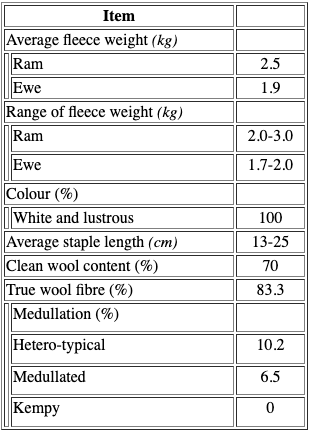
2.Bajad sheep
This breed is reared in Malchin, Khirgas and the East Gobi districts of Obsnuur province, but since 1967 sheep of this breed have been reared in many other provinces as well. Flock size is from 500 to 600. The breed is reared for its meat, wool and milk. Live weights at birth are 3.8 kg for males and 3.5 kg for females. Adult live weight is 72 kg for rams and 56 kg for ewes. The colour of the body is white but the head, face and neck may be white or fawn with black or brown rings around the base of the eyes.
Breed characteristics are a compact body with a straight, broad round back, well-developed hindquarters and broad loins. The head is of medium size with a slightly Roman nose and wide nostrils. The neck is strong and well developed with fleshy shoulders. Weighing 2 to 4 kg, the fat-tail is thick, broader at the base and reaching down to the hocks. Rams are occasionally horned and 47 per cent of ewes have horns.
Age at first lambing is between 15 and 18 months and breeding is generally allowed in September to October. Males and females are used for breeding for six to seven years. Ewes usually lamb once a year and twins are rare. Rams are generally selected for breeding on the basis of body weight and conformation. Body measurements are given in Table 3.

The quality of the mutton is very good, with the fat-tail also being important. The dressing percentage is 45.4 and milk production from 200 to 800 g per day. Wool characteristics of the Bajad are given in Table 4.
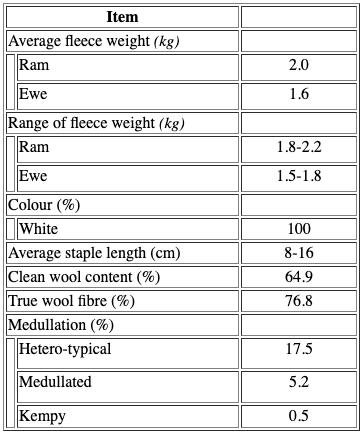
3.Barga sheep
The Barga sheep are found in the Khuleng Boir district of the Eastern Aimak province. Average flock size is 800 with a range from 600 to 2000. The Barga is used mostly for meat and wool. Live weights at birth are 3.5 kg and 3.2 kg for males and females, respectively. The average adult live weight of rams is 70 kg and that of ewes 50 kg. The colour of the body is white while the head is generally tan or brown- or black-spotted. The neck and legs are white but may sometimes be black- or brown-spotted on the knees and hocks.
Breed characteristics are a large, well-ribbed, compact body with a straight back. The neck is medium-sized, strong and well developed; and the ears are from medium to small. The fat-tail is thick, broader at the base and reaching down to the hocks, and weighs from 3 to 5 kg.
Barga is pure-bred and age at first lambing is from 15 to 18 months. Generally, singles are born once a year or even less frequently. Rams are selected primarily for body size and males that are unsuitable for reproduction are castrated at 45 to 60 days. Males and females are bred up to six or seven years of age. The breeding season is from September to October. Body measurements are given in Table 5.

The mutton quality is very good and juicy. Mutton from four- to six-month-old lambs, called zum, is considered a traditional delicacy. The dressing percentage is 47.9. The breed is not milked. Wool characteristics are given in Table 6.
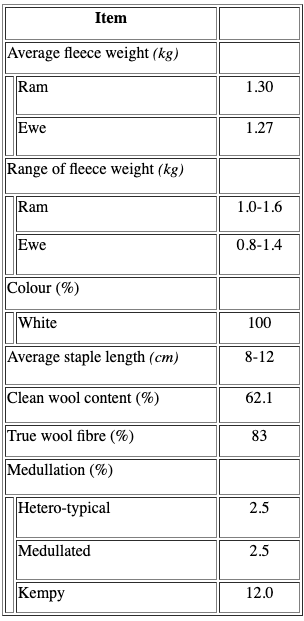
4.Darkhad sheep
The name originates from the Darkhad race of the Hobsguul district in which the breed has its home place. Flock size is from 500 to 600 and the breed is kept for its meat, wool and milk. Average live weight at birth is 3.6 kg for males, 3.1 kg for females, 71 kg for adult rams and 51 kg for adult ewes. The colour of the body is mostly white. The head, face and neck may be black or brown, with black or brown rings around the base of the eyes.
The characteristics of the breed are a compact body with a straight back, well-developed hindquarters and broad loins. The head is of medium size with a narrow forehead and prominent eyes. The neck is long to medium in length, well developed, with fleshy shoulders. The is short – 5 to 10 cm long – and plump, and the legs are strong. Some males may have horns, while females are polled.
Age at first breeding is about 18 months. The main breeding season is in the autumn and mating continues for two months. Not more than one lamb is born per ewe per year. The breeding age for both rams and ewes lasts six to eight years. Body measurements are shown in Table 7.

The dressing percentage is 42.6 and mutton quality is good. Milk production amounts to 200 to 600 g daily. Wool characteristics are given in Table 8.
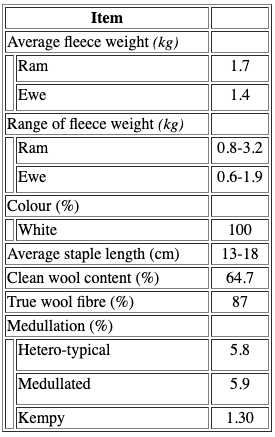
5.Gobi-Altay sheep
The name is derived from the location of the breed beyond the Gobi-Altay mountain area in the province of that name. On average, flock size is 500, with a range of 400 to 600, and the- breed is reared for meat, wool and milk. Live weights at birth are 3.5 kg for males and 3.3 kg for females; while adult live weights are 68.8 kg for rams and 54 kg for ewes. The colour of the body and neck of the Gobi-Altay sheep is white, although the head, ears and hocks are generally brown or grey, or even black.
Breed characteristics are a straight back with a medium-sized head and a slightly Roman nose. There are black rings around the eyes, and the neck is thin, long and slender. The quarters are moderately developed, while the fat-tail is thick and pendulous and reaches the hocks. It weighs from 2 to 4 kg.
Age at first breeding is between 15 and 18 months and the lambing interval is ten to 12 months. Usually, single lambs are born. Males and females are used for breeding for six to seven years. Rams of this breed are in demand for improving wool quality in other areas of Mongolia. Body measurements are given in Table 9.

The dressing percentage is 46 and the fat-tail is very important. The quality of the mutton is both good and juicy, and milk production amounts to 200 to 600 g per day. Wool characteristics are given in Table 10.
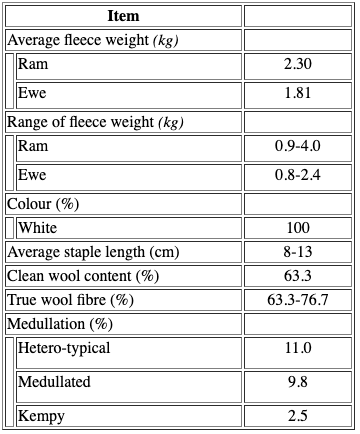
6.Karakul sheep
The Karakul is bred in the Sumbur district of East Gobi province. Since 1956, the semi-desert of the Gobi in the extreme south has been allocated to Karakul breeding. Flock size is from 500 to 600 and the breed is kept mainly for lambskins, meat and milk.
Liveweight at birth is 3.7 kg for males and 3.5 kg for females. The average live weight of the adult ram is 65 kg and of the ewe 46 kg.
The colour of the Karakul sheep is mainly black or grey. Characteristics of the breed are a compact body with a straight back and slightly pendulous belly which is covered with wool. The head is medium-sized with a bulging forehead and medium-sized ears. The neck is thin, long and well set at the thorax. The shoulders are straight and fleshy. The quarters are moderately well developed and the fat-tail is medium-sized, weighing from 2 to 3 kg and touching the points of the hocks.
Age at first breeding is 18 months and ewes usually lamb once a year. Lambing percentages vary from 105 to 130 and mating is allowed in September and October. Breeding males and females are generally used for five to seven years. Body measurements are given in Table 11.

The dressing percentage of this breed is 46 and the mutton quality is good. Milk production is from 300 to 600 g daily. Wool characteristics are given in Table 12.
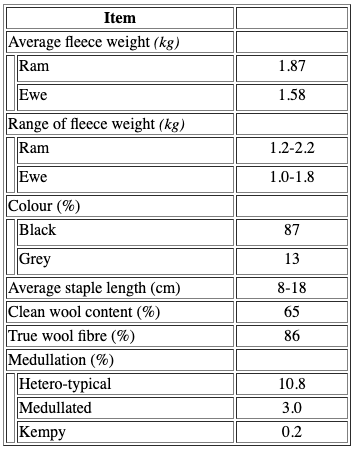
7.Kazakh sheep
The Kazakh sheep of Mongolia is bred in the Bayan Ulegei province and flock size of this breed ranges from 550 to 600. It is reared mainly for meat, milk and wool. Live weights at birth are 3 kg for males and 2.8 kg for females. The average live weight of the adult ram is 70.1 kg and of the ewe 56.1 kg.
This breed grows a coarse wool fleece, mainly of varying brown colours. The fibre, however, maybe black or grey. Fleeces are used in the making of carpets and rugs. Characteristics of the breed are a compact body with a straight, or sometimes an arched, back. The head is medium-sized with a Roman nose. The neck is long and well set at the thorax. The legs are long, stout and covered with short, coarse wool. The rams are horned and 70 per cent of the ewes are polled. The ears are long and drooping. The quarters are moderately developed but the rump is well developed. The tail is set high on the rump which is thick, plump and broader than the body. The tail extends just far enough to cover the genitalia and ends bluntly, forming a “v”, which is usually devoid of hair. The udder is medium-sized and the teats are well developed.
The flocks are pure-bred and the age at first breeding is 18 months. Generally, lambs are born singly and are allowed to suckle until ewes are dry. The breeding season is from September to October. The breeding age lasts from six to seven years for ewes and a little longer for rams. Males that are Unsuitable for reproduction are castrated at 1.5 to two months of age and rams are selected for breeding on the basis of body size and fleece weight. Body measurements are given in Table 13.

The dressing percentage of this breed is from 41.1 to 47.6 and mutton quality is good. Milk production amounts to 200 to 600 g daily in lactations of 60 days. Wool characteristics are given in Table 14.
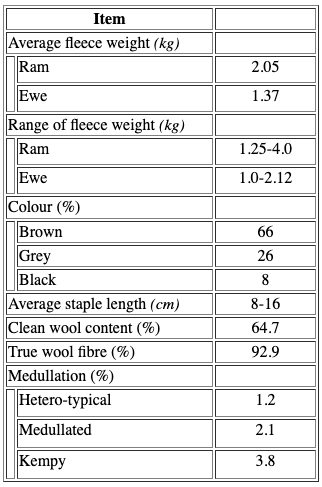
8.Khalkha sheep
This Mongolian fat-tailed sheep is an important breed not only in terms of its wide distribution in Mongolia, itself but also because it was the original “gene pool” for several other breeds which are now domesticated in different parts of the world. Flock sizes are from 500 to 1200 and the breed is kept mainly for meat, wool and milk.
The live weight of the Khalkha tends to vary seasonally and according to location. In the pastoral areas, the mean live weight for adult rams is from 65 to 75 kg, and from 50 to 60 kg for ewes. The colour of the body is usually white, and the head coloured. The breed is normally covered with coarse wool and is known locally as the “black-headed” sheep, although some animals do not- possess this characteristic. A blackhead is favoured by the sheep breeders since they are much easier to spot than whiteheads in the snow-covered areas. Thus, it probably gives the animal some advantage in selection for breeding. The predominant pattern is white with a coloured head, although different types of piebald and occasionally self-coloured animals are found.
Characteristics of this medium-sized breed are a compact body with a straight back. The head is small- to medium-sized with a bulging forehead. Ears are medium-sized and the neck is of medium size and well set at the thorax. The shoulders are straight and fleshy. The belly is somewhat pendulous and covered with scanty wool. Rams have curved horns and females are polled. The fat-tail is medium-sized, weighing 1.5 to 4 kg. The legs are straight and stout and covered with short, coarse wool.
Age at first breeding is 15 to 18 months and the main breeding season is autumn, with mating continuing for 45 days. Generally, single lambs are born once a year. Male lambs not selected for breeding are castrated at two months of age and sold at the age of six months to two years. Rams and ewes are used for breeding up to six or seven years of age. Body measurements are given in Table 15.

The dressing percentage is 46.5 and mutton quality is very good. Milk production is from 70 to 130 g daily. Wool characteristics are given in Table 16.
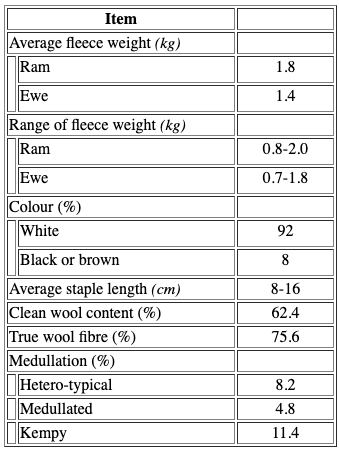
9.Khangai sheep
This new fine wool breed was developed in the Zagaan Nuur district of Selenga province by crossing local coarse wool native sheep with fine wool sheep breeds from the USSR; for example, Altay, Goznen and Stavropol. The Zagaan Nuur district is located in the Selenga River valley in the northern part of Mongolia. The Khangai breed was approved by the Mongolian Government in 1977.
Flock size ranges from 400 to 500 and the sheep are bred for its fine wool and meat. Liveweight at birth is 4.2 kg for males and 3.8 kg for females. Liveweight of adult rams is 80 kg and of adult ewes 58 kg.
Characteristics of the Khangai are a compact body with a straight back and slightly pendulous belly, which is covered with wool. The head is medium-sized with a straight nose and medium-sized ears. The neck is thin, long and well set at the thorax. The shoulders are straight and fleshy and the legs straight and thin. The tail (15 to 20 cm long) is also thin. All rams are horned and ewes are polled. The colour of the Khangai is completely white.
Age at first breeding is 18 months and lambs are generally born as singles. Males and females are used for breeding for six to seven years and lambing percentages vary from 110 to 130. Body measurements are given in Table 17.

The dressing percentage of this new breed is 47. Its mutton quality is fair and milk production is from 300 to 700 g per day. Wool characteristics are given in Table 18.
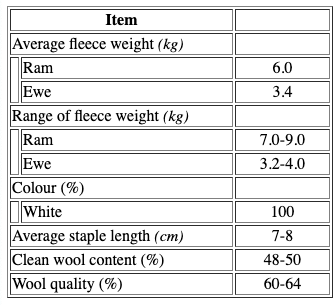
10.Orhon sheep
This semi-fine wool sheep of the central steppe zone has been developed from the F1 progeny of Mongolian fat-tailed ewes and precocious Soviet Marino or Tsigai and Altay rams, which were used on successive generations of cross-breeds. Named after the Orhon River, this breed was approved by the government in 1961.
Flock size ranges from 400 to 500 and the breed is reared for its meat, wool and skin. Average liveweight at birth is 4 kg for males and 3.6 kg for females; liveweight of the adult ram is 80 kg and of the ewe 57 kg.
The colour of the Orhon sheep is completely white. Characteristics of the breed are a compact body with a straight back, head and ears of medium size, with the latter tapering at the points. The neck is thick and strong, broader at the base and narrower toward the head. The legs are medium and stout and covered with wool; the tail is long (about 20 cm) and thin, and is cut at an early age. Eight percent of rams are horned and all females are polled.
Age at first breeding is 18 months and lambs are generally born as singles, although the twinning rate is 10 to 30 per cent. Males and females are used for breeding for six to seven years. Breeding is predominantly pure and rams are selected primarily for body size and for the weight and quality of their wool. Body measurements are given in Table 19.

The dressing percentage of this breed is 50 and the mutton quality is good. Milk production is about 300 g per day. Wool characteristics are given in Table 20.
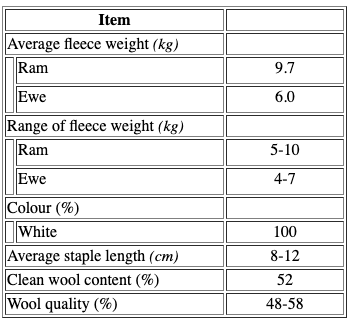
11.Sutai sheep
The name is derived from the location of the breed beyond the Sutai Mountain in the Darib district of Khobot province. Flock size is from 500 to 550 and the breed is kept mainly for meat, wool and milk. Liveweight at birth is 3.5 kg for males and 3 kg for females. The average live weight of adult rams is 72.5 kg and of adult ewes 57.4 kg. The body colour of the breed is white, and the head is black or brown, with black rings around the eyes.
Characteristics of the breed are a compact body with a straight back and a comparatively higher posterior. The head is medium-sized with a Roman nose. The legs are brown with dark spots and black hooves. The fat-tail is medium-sized and the ears are broad, long and drooping. Sixty per cent of males and 15 per cent of females are horned. Age at first breeding is from 15 to 18 months. Males and females are used for breeding for 6 to 7 years. Body measurements are given in Table 21.

The dressing percentage is from 42.5 to 48.1 and the mutton quality is juicy and good. Wool characteristics are given in Table 22.
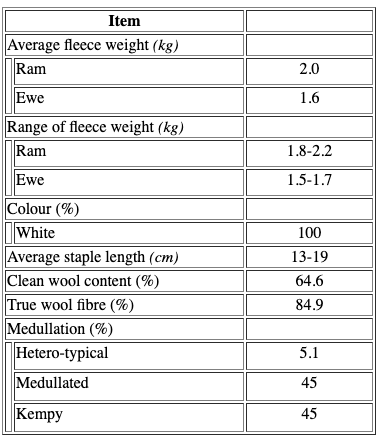
12.Torguud sheep
The name is derived from the Bulgang, Altay and Uengch districts of Kobdo province in the western part of the country. This region, which includes the Altay Mountains, has been assigned to the production of mutton, fat and carpet wool. The Torguud breed belongs to the fat-rumped, carpet wool type. Flock size is from 600 to 800 and the breed is reared for its mutton, fat and carpet wool.
Liveweight at birth is 3.9 kg for males and 3.6 kg for females. Liveweight of adult rams is 85 kg that of adult ewes 65 kg.
The body is light grey or white in colour and the head and legs are brown, tan or even black. Characteristics of the Torguud are a large, leggy animal with a high-set body and broad chest. The body is well ribbed and compact with a broad, round back. The head is of medium size with a slightly Roman nose and wide nostrils. The neck is strong and well developed with fleshy shoulders. Rams are all horned, while about 35 per cent of ewes are polled.
Age at first breeding is 18 months and lambs are generally born once a year. Rams are selected based on body weight and conformation and breeding males and females are used up to six or seven years of age. The breeding season is from September to October. Body measurements are given in Table 23.

The dressing percentage is 48.9 and the mutton quality is good. Milk production is 60 to 100 g per day during a two-month lactation period. Wool characteristics are given in Table 24.
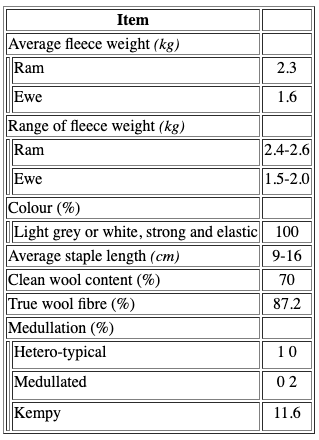
13.Tsigai sheep
Distribution of this semi-fine wool sheep is in the Herlen, Ulziit and Bayan Khutag districts of Khentei province and the Asgat district of Sukh-Batar province.
Flock size is from 500 to 800 and the breed is kept for its meat, wool, skin and milk. Average live weight at birth is 3.8 kg for males and 3.5 kg for females. The live weight of adult rams averages 76 kg and that of ewes 56 kg.
The breed’s colour is completely white and its characteristics consist of a well ribbed and compact body with a broad, round back. The hindquarters are well developed and the loins are broad. The head is medium-sized with a narrow forehead. Ears are white, leaf-like and tapering, 8 to 12 cm in length. The neck is strong and well developed, with fleshy shoulders. The tail is thin and 15 to 20 cm long. The udder is well developed with long teats (5 to 6 cm). Rams have curved horns and the females are polled. Body measurements are given in Table 25.

Age at first breeding is 18 months. Ewes usually lamb once a year and the twinning rate is 10 to 30 per cent. Mating is allowed in October and rams are used for breeding for five to six years, while ewes are used for six to seven years. The dressing percentage is 47, mutton quality is good and milk production is from 500 to 1000 g per day. Wool characteristics are given in Table 26.
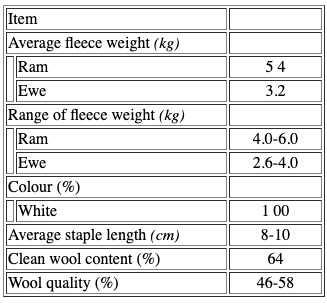
14.Uzemching sheep
The name originates from the Uzemching people of the Erdene and Zagaang districts of Sukh-Batar province. Uzemching sheep belong to the Mongolian fat-tailed type of sheep. The size of the majority of flocks is around 800 but they can vary from 600 to 1500. The breed is kept for its mutton and wool. Liveweight at birth for males is 3.8 kg and 3.5 kg for females. Liveweight of the adult ram is 73 kg while that of the adult ewe is 56 kg.
The colour of the body is white. The head is mostly black or brown and the hocks and knees of some animals have black spots.
Characteristics of the breed are a compact body with a straight and long back and slightly pendulous belly, covered with scanty wool. The neck is thick, strong, broader at the base and well set at the thorax. The shoulders are straight and fleshy and the quarters are well developed. The breed has a fat-tail that is 26 cm long and 32 cm wide in the made, and 22 cm long and 25 cm wide in the female. Legs are medium-sized and covered with short, coarse wool. The fat-tail is thick, broader at the base and reaching down to the hocks. It weighs from 3 to 6 kg. Rams have long, curved horns that spiral outward, while ewes are hornless.
Age at first breeding is 18 months. Usually, single lambs are born, and the main breeding season is in autumn when mating continues for nearly two months. Breeding males and females are generally used for five to seven years. Body measurements are given in Table 27.

The dressing percentage is 48.9 and the quality of the mutton is very good and juicy. The breed, however, is not milked. Wool characteristics are given in Table 28.
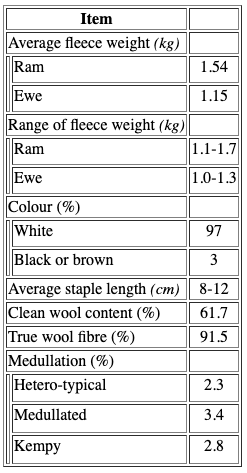
15.Yoroo sheep
This new semi-fine, the long wool breed was developed in the Yoroo District of Selenga province by crossing local fine and semi-fine wool sheep with semi-fine wool breeds such as the North Caucasian and the Romney-Marsh. The Yoroo district is located in the Yoroo River valley in the northern part of Mongolia. This new breed was approved by the government in 1981.
Flock size of the Yoroo breed is from 400 to 600 and it is reared mainly for mutton and wool. Average live weight at birth is 4.2 kg for males and 3.9 kg for females. Adult live weight is 85 kg for rams and 56 kg for ewes.
The colour of the breed is completely white. Breed characteristics consist of a body which is well ribbed and compact, with a broad, straight back, well-developed hindquarters and broad loins. The head is medium-sized and the nose has wide nostrils. The neck is strong, well developed and set on fleshy shoulders. The tail, which is thin, long and touches the ground, is cut at an early age.
Age at first breeding is 18 months and the twinning rate is 15 to 30 per cent. Breeding males and females are used up to six or seven years of age. The breeding season is from August to September. Body measurements are given in Table 29.

The dressing percentage is between 50 and 52, and the mutton quality is good and juicy. Milk production is from 300 to 600 g per day. Wool characteristics are given in Table 30.
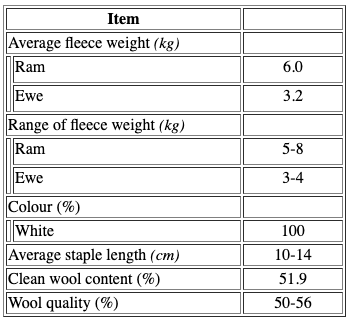
Source : www.fao.org/3/u4900T07.htm
